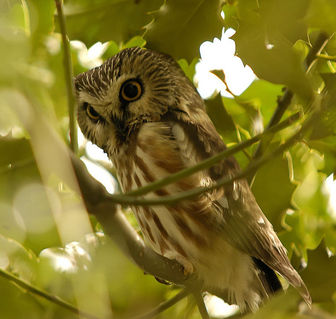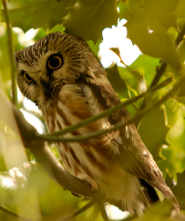Northern saw-whet owl
The Northern Saw-whet Owl is a miniature owl native to North America.

Author: brendan.lally
Northern Saw-Whet Owl - Cute Trickster
 The Northern Saw-Whet Owl (Aegolius Acadicus), is a member of the Strigidae classification of owls from the 26 genera known as typical owls. This distinction is divided down to four Aegolius species commonly called 'small forest owls'. The Northern Saw-Whet is one of the smallest owls. They have a short, stocky build with a relatively short tail. The average Saw-Whet measures 7 - 8.5 or 18 - 22cm in length. Their weight ranges from 2.6 - 4.6 ounces or 75 - 130 grams. Wingspan of these forest owls are 17-21 inches or 23-53 cm.
The Northern Saw-Whet Owl (Aegolius Acadicus), is a member of the Strigidae classification of owls from the 26 genera known as typical owls. This distinction is divided down to four Aegolius species commonly called 'small forest owls'. The Northern Saw-Whet is one of the smallest owls. They have a short, stocky build with a relatively short tail. The average Saw-Whet measures 7 - 8.5 or 18 - 22cm in length. Their weight ranges from 2.6 - 4.6 ounces or 75 - 130 grams. Wingspan of these forest owls are 17-21 inches or 23-53 cm.
Acadicus indicates where the owls were originally sighted. European explorers came across them in a North America location called Acadia which is now Nova Scotia. The name Saw-Whet was coined because of the unique sound these owls emit. They are an attractive bird with fluffy plumage of brownish red streaked with white and spotted underneath. Their flight feathers are spotted with white. The owls have a rather large head and unlike other owls, no ear tufts.
Northern Saw-Whet owls live and nest in dense forest areas. They prefer coniferous trees but will roost in heavy shrubs. They often build their nests in places where woodpeckers, like the Pileated and Northern Flicker, have hollowed out a hole. They prefer to nest alongside creeks and streams. Saw-Whet owls are carnivorous, existing mostly on small mammals, frogs and insects. They also kill and eat birds like sparrows, chickadees or even larger cardinals and doves. The Saw-Whet has a curious habit of 'freezing' their left-overs. Rarely do they eat an entire carcass but tear it in half and store the remaining meal inside the nest.
In breeding the male picks out the nest and lures the female with song, dance and a mouse in its bill. They breed from March through July, typical nest is five to six eggs. The male provides food during the broody season, about 21 days, but the female keeps the nest tidy. When the nestling are about 18 days old she finds a new home but helps feed the young owls for several weeks.
Northern Saw-Whet owls are not on an endangered list. Their predators are larger owls, Cooper's Hawks and similar raptors. Life expectancy is from five to eight years.
The Northern Saw-Whet owls are also tricksters. If found by humans they sit very still trying to impress them with their tameness and cuteness, when in fact they can be quite vicious.
Picture of the Northern Saw-Whet Owl by brendan.lally, licensed under the Creative Commons Attribution 2.0 Generic license.
The Northern saw-whet owl is classified as Least Concern. Does not qualify for a more at risk category. Widespread and abundant taxa are included in this category.

Original source: andresen_rt
Author: andresen_rt
Permission: Some rights reserved
Family : Strigidae
Genus : Aegolius
Species : acadicus
Authority : (Gmelin, 1788)

